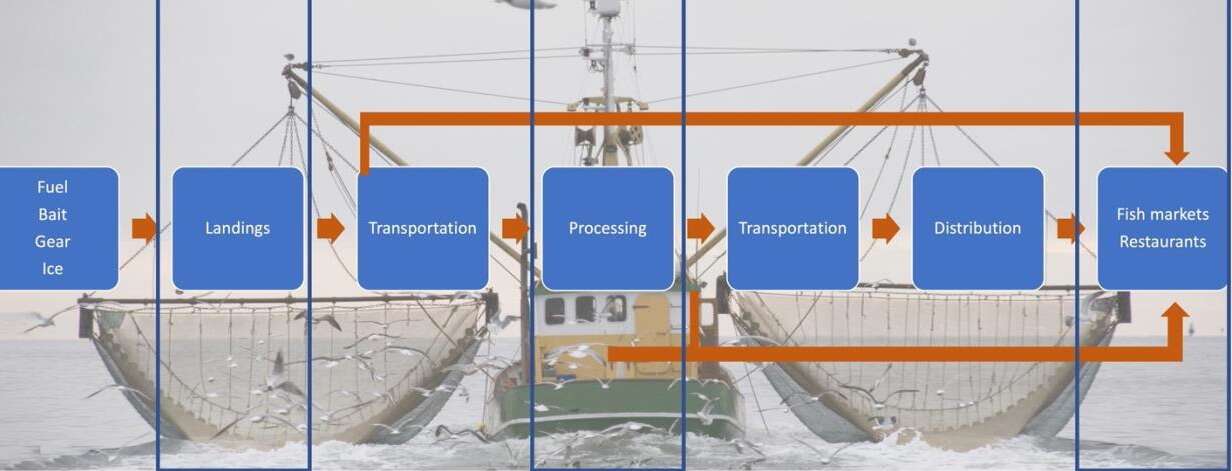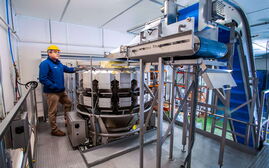
Seafood industry contributes $3.2B a year to the Maine economy, report says
 File photo / Laurie Schreiber
A first-ever economic analysis found Maine’s seafood sector had $3.2 billion in total output in 2019, driven largely by retail sales, lobster harvesting and seafood processing.
File photo / Laurie Schreiber
A first-ever economic analysis found Maine’s seafood sector had $3.2 billion in total output in 2019, driven largely by retail sales, lobster harvesting and seafood processing.
More Information
The first-ever report on Maine’s seafood sector as a whole, including downstream contributors, found in 2019, the sector contributed over $3.2 billion in total economic output to the Maine economy.
The largest contributors were retail seafood, at $692 million, followed by lobster harvesting at $511 million and seafood processing at $343 million.
The sector supported over 33,300 jobs statewide in 2019, including 23,846 in sector industries and 7,300 additional jobs supported by other indirect and induced multiplier effects.
The report was commissioned by Seafood Economic Accelerator for Maine, or SEA Maine for short.
“The seafood industry is one of the state’s biggest resources and a significant contributor to our economy,” said Charlotte Mace, director of the Department of Economic & Community Development’s Office of Business Development and a member of SEA Maine’s steering committee.
According to the report, harvesting of lobster, non-lobster species and aquaculture was the largest employing segment, supporting over 12,700 jobs. Next was retail seafood outlets, including restaurants, with 8,550 employees.
Employment supported $1.3 billion in total labor income; $967 million was from direct employment in value chain industries, and $336 million was from indirect and induced multiplier effects.
Contributions to labor income were led by lobster harvesting ($393 million), retail ($285 million), and all non-lobster species harvesting ($155 million).
Seafood industries collectively supported an estimated $449 million in tax revenues in 2019. That broke down to nearly $91 million in local, $110 million in state and $248 million in federal tax revenues.
The sector was a key contributor to the prosperity of Maine’s coastal communities.
“Having this type of data helps inform the best ways to diversify and grow our marine economy," Mace said.
Baseline data
SEA Maine is an industry-led initiative that brought together leaders in Maine’s commercial fishing, aquaculture and marine economy.
Funded by the U.S. Department of Commerce’s Economic Development Administration, with match funding from the Maine Technology Institute and FocusMaine, the statewide initiative is developing a roadmap and action plan for economic growth, market and workforce development, and greater resiliency in Maine’s seafood economy.
The goal of the analysis was to quantify, for the first time, the economic contribution of the entire sector to the Maine economy and provide tools to make data-driven policy decisions regarding the sector as a whole and the marketing of the sector.
The report focuses on the domestic commercial seafood sector. It’s intended to serve as a baseline to measure growth and evaluate the impact of specific investments or initiatives.

“Creating an economic baseline for the entire seafood sector is a fundamental building block for Maine,” said Maine Aquaculture Association Executive Director and SEA Maine member Sebastian Belle. “This baseline study will allow us to accurately measure growth going forward and help attract investment.”
The report provided a regional breakdown of the numbers.
Downeast
- Accounted for 45% of all direct jobs (and 47.4% of total impact jobs) and supported $390 million in labor income (16%) in 2019.
- Supported slightly more jobs in the Downeast region than in the southern Maine region, despite having less than one-fifth of the population.
- Downeast seafood jobs were concentrated in the harvesting subsector — the region accounted for 65% of all harvesting jobs in the seafood sector statewide in 2019, accounting for nearly 3,700 jobs.
Midcoast
- Supported over 10,000 jobs and over $260 million in labor income in 2019.
- Economic impacts were concentrated in lobster harvesting and retail; aquaculture comprised a smaller but growing source of jobs and income.
Southern Maine
- Supported over 7,600 jobs and $370 million in labor income — slightly less than Downeast.
- The bulk of direct jobs were supported by the retail industry sector (over 4,000), while harvesting (all species wild-caught) supported roughly 1,240 jobs.
The study focused on 2019, before the pandemic. It concludes that continual updating and improvement of economic data should be a priority for the industry and policymakers.
“We need to embrace these opportunities and educate people on the resiliency of this resource we have here in Maine and show how we are poised for economic growth,” said Ben Martens, executive director of the Maine Coast Fishermen's Association and a SEA Maine Advisory member.
The report was undertaken by the Middlebury Institute for International Studies Center for the Blue Economy and the University of Southern Maine Center for Business and Economic Research.
To view the full report, click here.














0 Comments